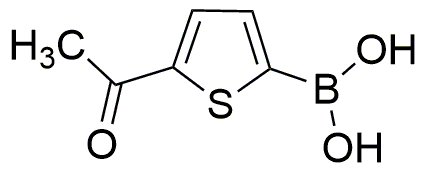5-Acetyl-2-thiopheneboronic acid is widely utilized in research focused on:
- Organic Synthesis: This compound serves as a versatile building block in the synthesis of various organic molecules, particularly in the development of pharmaceuticals and agrochemicals.
- Drug Development: Its unique boronic acid functionality allows for the creation of targeted drug delivery systems, enhancing the efficacy of therapeutic agents in treating diseases such as cancer.
- Material Science: It is employed in the fabrication of advanced materials, including conductive polymers and sensors, due to its ability to form stable complexes with metals.
- Biochemistry: In biochemical research, this compound is used to study enzyme interactions and mechanisms, particularly in the context of protease inhibitors.
- Environmental Chemistry: It plays a role in the development of sensors for detecting environmental pollutants, contributing to efforts in monitoring and improving environmental health.
General Information
Properties
Safety and Regulations
Applications
5-Acetyl-2-thiopheneboronic acid is widely utilized in research focused on:
- Organic Synthesis: This compound serves as a versatile building block in the synthesis of various organic molecules, particularly in the development of pharmaceuticals and agrochemicals.
- Drug Development: Its unique boronic acid functionality allows for the creation of targeted drug delivery systems, enhancing the efficacy of therapeutic agents in treating diseases such as cancer.
- Material Science: It is employed in the fabrication of advanced materials, including conductive polymers and sensors, due to its ability to form stable complexes with metals.
- Biochemistry: In biochemical research, this compound is used to study enzyme interactions and mechanisms, particularly in the context of protease inhibitors.
- Environmental Chemistry: It plays a role in the development of sensors for detecting environmental pollutants, contributing to efforts in monitoring and improving environmental health.
Documents
Safety Data Sheets (SDS)
The SDS provides comprehensive safety information on handling, storage, and disposal of the product.
Product Specification (PS)
The PS provides a comprehensive breakdown of the product’s properties, including chemical composition, physical state, purity, and storage requirements. It also details acceptable quality ranges and the product's intended applications.
Certificates of Analysis (COA)
Search for Certificates of Analysis (COA) by entering the products Lot Number. Lot and Batch Numbers can be found on a product’s label following the words ‘Lot’ or ‘Batch’.
*Catalog Number
*Lot Number
Certificates Of Origin (COO)
This COO confirms the country where the product was manufactured, and also details the materials and components used in it and whether it is derived from natural, synthetic, or other specific sources. This certificate may be required for customs, trade, and regulatory compliance.
*Catalog Number
*Lot Number
Safety Data Sheets (SDS)
The SDS provides comprehensive safety information on handling, storage, and disposal of the product.
DownloadProduct Specification (PS)
The PS provides a comprehensive breakdown of the product’s properties, including chemical composition, physical state, purity, and storage requirements. It also details acceptable quality ranges and the product's intended applications.
DownloadCertificates of Analysis (COA)
Search for Certificates of Analysis (COA) by entering the products Lot Number. Lot and Batch Numbers can be found on a product’s label following the words ‘Lot’ or ‘Batch’.
*Catalog Number
*Lot Number
Certificates Of Origin (COO)
This COO confirms the country where the product was manufactured, and also details the materials and components used in it and whether it is derived from natural, synthetic, or other specific sources. This certificate may be required for customs, trade, and regulatory compliance.

